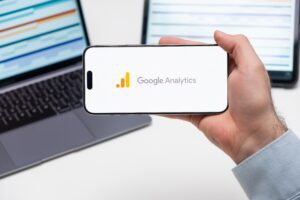
Reflection time: How PPC reporting can help you improve your ad campaigns

Here at Embryo, our PPC’s relationship with clients doesn’t stop as soon as your campaign starts to turn a profit. Even after you’ve seen an increase in conversion rates and conversion value, it’s important to continue to monitor your business performance. You can do this by setting realistic goals and constantly drawing from marketing blogs and external business strategies so that you’re always working at maximum PPC.
Investing in your business’ future

Think of PPC performance like learning a language, or exercising a muscle. If you don’t use it you’ll lose it. That’s why it’s important to carry out regular reviews and frequent monitoring – not just when something is going wrong – but in order to keep up with the constant evolutions and developments taking place in the digital marketing industry.
Regular reviews will help you measure expenditure and adjust budgets accordingly, see which ads are performing best (and why), and which keywords are generating the highest paid traffic.
We’re not going to beat around the bush here. If you’re serious about your business’s future, you need to invest not just time but also money into making it more appealing to an audience that’s most likely to be interested in your products and services. SEO is a great marketing strategy for driving organic traffic, and in fact people are more likely to click on organic search results than paid content, according to a recent study. However, PPC is more likely to generate faster results in order to grow your business more quickly.
Go in with a plan
When it comes to measuring your PPC performance, it’s useful to have specific goals which help you establish a metric for your progress. Realistic goals could include (but are certainly not limited to) increasing your landing page’s conversion rate, driving brand awareness, and generating quality leads.
Each business will have goals specific to their marketing model and company values, but generally speaking if you’re looking to make a profit by generating a positive ROI from PPC, visibility and customer engagement should be at the top of your list.
Drawing from data generated by your current ads and PPC strategy will allow you to set specific goals from an experienced and well-informed business perspective.
Defining the data in your PPC report
If you’re using Google Ads for your PPC, and most likely you are given that it’s the most popular PPC platform, you can make use of its useful reporting feature which enables you to produce downloadable custom reports with different columns and inclusions.
The results your report will yield depends on the parameters you use so it’s important to understand how metrics like CPC, CTR and CPA reflect your PPC performance.
—
CPC (cost per click) is a financial metric that allows you to assess the effectiveness of your adverts by showing you how much money is being spent compared to how much return on investment your campaign is bringing in.
CPC also allows you to set limits on your PPC budget so that you don’t pay more than you’re willing per click. Your max CPC is the maximum you would be charged each time a user clicks on your ad, but often you’ll be charged less – this is called the actual CPC. You can either choose these bidding metrics manually so that you’re in control of your bid amounts, or leave it to one of Google’s automated bid strategies which will accelerate your bid during a period of optimum impressions.
One of Google’s most useful bidding options is Enhanced Manual CPC, where you can manually set your bids per keyword but Google cleverly adjusts your cost per click in order to help maximise conversions or conversion value by assessing variations in periods of ad interactions.
—
CTR (click through rate) is a way of gauging how well your keywords and ads, and free listings, are doing. You should be aiming for a high CTR as this indicates that your ad was appealing enough to make someone click on it and through to your website.
Things like specific keywords and appealing imagery can help you increase the overall quality of your ad copy. On Google Ads you can also make use of expanded text ads which allow three headlines instead of two, as well as a second description and a longer character limit for each line.
Adding extensions to your ads can also help increase click-through rates. This might take the form of a call button, location information, or links to more specific pages of your website.
Click-through rate can be calculated by dividing the number of impressions your ad receives by the number of clicks.
—
CPA (Conversions Cost per acquisition) is a KPI (key performance indicator) used to measure how much it costs a company to lead a customer all the way down the sales funnel, from the very first impression to the completed conversion.
This is different from ROAS (return on ad spend) which is the revenue you make in relation to your advertising costs. It takes into account all of the overhead costs, including marketing, sales, salaries, raw materials and overhead costs involved in the lead generation process.
To calculate the cost per acquisition, you need to divide the total cost (either of an individual campaign or of your PPC spend in total) by the number of conversions (new customers) produced by that campaign or market strategy.
As well as these metrics, more general data analytics like bounce rates, ad traffic, and time spent on page can also be useful information for a PPC report as it helps you to identify what you’re doing well – and not so well – so that you can build on your PPC campaign and strategy.
Ignoring tools is for fools

When drawing up a PPC report, you’d be a fool not to use the plethora of tools at your disposal. Platforms like Google Ads boast heaps of helpful analytics tools and reporting features.
Google Analytics for example is particularly useful as you can link it directly to your Google Ads account. It works by collecting data from your websites and apps. This helps you to better monitor your performance by producing monetization reports which reveal the revenue which enables you to evaluate the ROI (Return on Investment).
As well as built-in tools like this you can use other analytic services such as Whatagraph, DashThis, Semrush or AgencyAnalytics.
Conversions, campaigns and now, a conclusion
In order to optimise your ad campaigns and drive the highest paid traffic to your website, it’s fundamental that you’re aware of how well your current ads are performing. This is even more important as the digital marketing industry continues to expand and PPC is constantly impacted by new trends in consumer behaviour and the competitive advertising market. Through constant monitoring and regular reviews you can continue to develop the most advantageous PPC campaigns as you continue to grow your business.
FAQs
Answered by Tom McGuigan
Can I use PPC campaigns on and off or is it best to stay consistent?
For high-performing campaigns, it is best to stay consistent. Google operates best with data, specifically the last 30 days of data, for automated bidding. Having updated data for Google to make decisions from, will more often than not provide high-quality campaigns.
Is a new PPC campaign a trial and error process?
For a business doing PPC for the first time, starting a campaign can only be based on data collected internally by the company. As campaigns are running, data can be collected on what is and isn’t working, which is the ability to inform future decisions surrounding campaign direction. This premise applies to all PPC campaigns, and it is best to refine and update as data is collected
Is Google Analytics free to use?
Google Analytics is free to use and has all the basics to set up and run ad campaigns. Paid versions come with added extras to better inform campaign direction and performance.
Does Embryo provide reporting on a weekly or monthly basis?
Embryo can provide reporting tailored to each client’s needs. This frequency of communication is flexible and can change depending on the client’s needs.